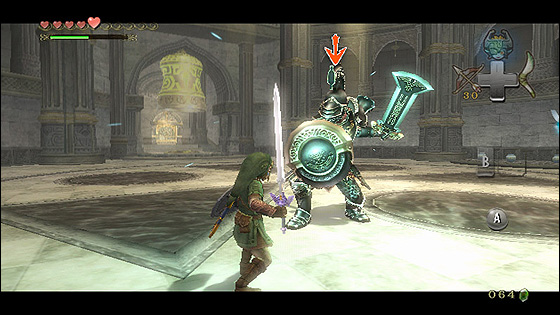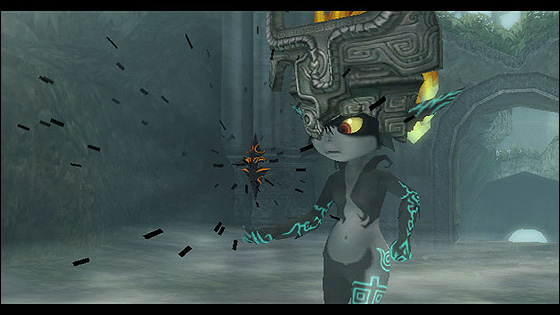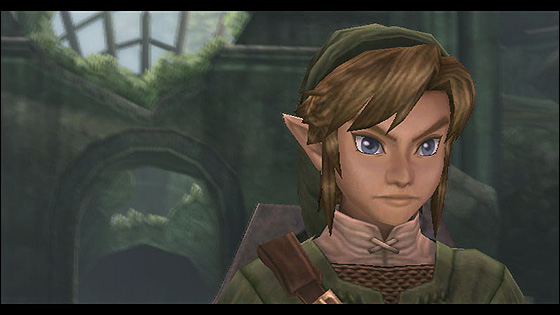Zelda: Twilight Princess – Conformity, Innovation and Relevancy
July 5th, 2009

After a prolonged on-off play through of The Legend of Zelda: Twilight Princess, one thing becomes remarkably clear about the whole experience. Twilight Princess ultimately strives and fails under the weight of its own legacy.
There are many prominent examples which I could use to substantiate my ideas. I’ll go with my favourite; the Stallord – ie. mega stalfos – boss from the Arbiter’s Grounds temple.
The battle begins with Stallord resurrected by the evil Zant. The creature rises then sits in the centre of a sand-filled bowel, raised only by a spine of individual bones, using his skeletal hands to support his hunch over the arena. The bowel is filled with sand which draws stationary objects away from the rim of the arena. Link uses his spinner to grind around the rim of the bowl, before launching towards the Stallord, with the aim of denting his spinal support in the centre. The boss soon summons legions of the undead to deflect and obscure Link’s spinner. The dynamic begins to play out as a sort of circular pinball machine with obstructions (the undead and Stallord’s hands) acting as bumpers to shield the spine from damage.
As with all Zelda dungeons, this boss battle works as an exercise testing the item-of-choice for each respective dungeon, in this case the spinner. It demands the player to apply their recently acquired knowledge of the device [spinner] to a practical example. As the battle unfolds and the means to victory becomes increasingly more elaborate, with a heightened number of obstacles, Link must appropriate his strategies differently in order to defeat the boss – the game incites the player to reconsider and reapply their former understanding of the game world.
This begins, as it usually does with the later Zelda boss battles, by first increasing the difficulty of the initial confrontation (ie. presence of undead minions, aggravation of the Stallord itself) before entering a second phase. Each phase requires a different problem solving technique.
It’s the design of these levels of elevation where Nintendo’s prowess comes into it’s own. The first scenario of the Stallord confrontation is concentrated in the centre of the arena – although Link twirls along the rim of the arena, the player is more conscious of their access to the spine. The player’s movement is also from vertical top to vertical bottom and from outwards to inwards, as Link glides into the base of the arena. They’re effectively using the spinner as a pinball.

In the second section, the sand sinks revealing a circular platformer in the middle surrounded by a waterless moat. The Stallord knocks Link down into the lower levels where Link must use the spinner to climb his way back to the top, before being interrupted by the creature’s floating head. Once Link leverages enough height he can transfer between rims knocking the head in the process. Somehow reminds me very much of the Cave of Wonders from Aladdin.
Here we see Nintendo applying an opposing design to the previous section, demanding the player to again re-adapt to the changing situation. The player moves from vertical bottom to vertical top and concentrates on the inner and outer rims of the moat, travelling left to right. By turning the arena on it’s head Nintendo have opened up a new design demanding the player operate on different axes of thought which inturn forces the player to think laterally as to how to complete the second phase of the battle. This time the spinner is instead used as a device to hop between surfaces.
These two parts fit together to create a very engaging and original piece of gameplay which engross deeply in the player’s mental approach to problem solving. The resurrection of the boss half-way through was, of course, a fitting surprise, but the way the game challenges the player through clever design logic which expounds the usage of the spinner is what crafts an overall challenging and enjoyable experience.
The memories that I’ll most take away from Zelda: Twilight Princess are the moments such as the above example, which are either cleverly designed elements or examples of pure creativity both implemented in a wonderfully Nintendo manner. Midna and the Twilight world, the original items such as the spinner, ball and chain and Bionic Commando-esque double hookshot, sumo wrestling with Gorons, snowboarding with a crazy Yeti, dueling Gannondorf on horseback, canoeing and the final few dungeons. These examples engaged me deeply and often made me laugh out loud at the pure ingenuity.

The more I continued to play Twilight Princess the more resounding this argument became in my head. Twilight Princess seems to be a battle between inspired and iterative capital. While not all capital borrowed from previous games is by any means bad, it is familiar territory, and for fans, a fair deal of it can be considered tired. This is no doubt exacerbated by the foundation of Twilight Princess‘ core which is -as the fans demanded- a graphically realistic, traditional Zelda experience in the vein of Ocarina of Time. Naturally, the fans aren’t game designers and their request is invariably different from their desires. The idea of a mechanically-considered sequel to Ocarina of Time (ie. not the direct-sequel, Majora’s Mask) is wrought with its own implications which defeat the prospects of a “proper” sequel. Games after all, exist within the times, and really what should be asked for is not another Ocarina of Time, no, the next Ocarina of Time – an Ocarina of Time we haven’t even imagined yet. Whether or not such a title should bear so much likeness to Ocarina is out of the question – “next” frankly doesn’t mean “same”. So maybe Zelda: Wind Waker is closer to a truer sequel than what some people might have originally believed.
A mechanically-considered sequel to Ocarina of Time – such as Zelda: Twilight Princess – is faced with numerous design challenges. Firstly the narrowing of the technological gap means that there isn’t terribly much Twilight Princess can do which couldn’t have been done on the N64, relative to the SNES-N64, and other technological jumps. The Wii motion control is the key exception here. Secondly, with more installments behind it, the foundation mechanics for the series were exhausted to a higher degree with the later Twilight Princess than with the earlier Ocarina of Time and Wind Waker, this demands an increased level of innovation in order to match the elevated abundance of increasingly laboured mechanics. Thus, Twilight Princess can ultimately be judged by fans on the disparity between inspired and tired capital.
A Brief Aside (Majora’s Mask)
Just a quick digression, I want to elaborate on my case using Zelda: Majora’s Mask. Majora’s Mask represents the converse choice to the traditional approach. The title takes the previous frameworks and twists it on its head to create a different play environment. Because the framework of the whole game is reworked, it naturally refaces the familiar content, in turn creating a refreshingly innovative interpretation of the series. For example, the Goron, Zora and Deku tribes are all staples of the series. Putting on a mask and transforming into either race, changes the way you are perceived by either culture. They respond to a Hylian very differently than one of their own and the dialogue reflects this. Further, you are now given access to the backstages of their sorted societies, which open up unique gameplay scenarios.This reinvigorates our already familiar understanding of these tribes and injects it with different angles, interpretations and information.
Back to Main Article
The reason why I care so much about the scales of innovation is because it determines the overall quality of the games, but perhaps more importantly it is proportional (or at least heavily skewed by) the relevancy that franchises such as Mario and Zelda have within the video game industry.
As you’re likely already quite familiar with, the uprising of western developers in recent years is threatening to make Japanese developers – and Nintendo’s big three – continually less and less relevant. Take the following example, back late last decade the boss battles in Ocarina of Time were considered the most intense seen in the industry. Fast forward some years and we can see a marked difference between say a Zelda: Twilight Princess and a God of War. In the years since Ocarina of Time, such studios as SCE Santa Monica have been honing their craft, a craft which – generally speaking – appeals strongly to a western audience. Last year’s E3 presentations, a pissing match between Sony and Microsoft as to who can offer the greatest sense of scale is largely indicative of that.
If we then revisit the Skullord boss battle and contrast it against, say, the Hyrda battle opening the original God of War (2005), the disparity in theatrical quality is vastly different. Whilst, Twilight Princess is no slouch theatrically, it pales in comparison to the finely executed God of War. Clearly in the span of a few years, these folks have literally gobbled up prime real estate which the Big N use to occupy. On the flipside, the Skullord is much more elegantly designed and in that sense can be considered superior, it all depends on tastes.

When it comes to Ninty domination, not only are we talking theatrics and dramatization, this is happening on many fronts; Nintendo’s key franchises are fighting to stay relevant and in my mind, Twilight Princess represents Nintendo grappling with that, slouching a little – it’s the embodiment of all this drama. Zelda, Mario and Metroid are the oldest classics in the book and they need constant reinvention to stay fresh. While Twilight Princess is the strongest embodiment of series ideals, it’s also the largest, most endearing Zelda title which are the reasons cited as to why it’s the best in the series. The clash between old and new, exhausted and fresh material represent a stumbling block in the series, as it waits for the next round of revolutionisation, but as with every title in the series, it represent something. It highlights that Nintendo should not become complacent with reusing familiar material as many have inferred the company doing so with Twilight Princess. In a sense, one might argue that fan’s wants ultimately dwarfed the series as despite it’s weaker content, The Wind Waker was a thoroughly more adventerous and innovative title than the conformative Twilight Princess.
This isn’t a cause for alarm though. If we can take anything out of this year’s E3, it’s that these western developers are now in pursuit of Nintendo’s innovation, they want to taste the success that trickles from the river of great ideas. Nintendo have forged their own trail, remarkably so, Twilight Princess (much like the Gamecube) is therefore the stepping stone required to reach that path. It’s representative of the state of Ocarina of Time in 2006. Evokes many ideas of where the series will go next, eh?
Additional Readings



 Game Design Companion: A Critical Analysis of Wario Land 4 - $7.99
Game Design Companion: A Critical Analysis of Wario Land 4 - $7.99 Level Design: Processes and Experiences
Level Design: Processes and Experiences Speed Boost: The Hidden Secrets Behind Arcade Racing Design - $5.99
Speed Boost: The Hidden Secrets Behind Arcade Racing Design - $5.99 Adventures in Games Analysis: Volume I - $5.99
Adventures in Games Analysis: Volume I - $5.99







